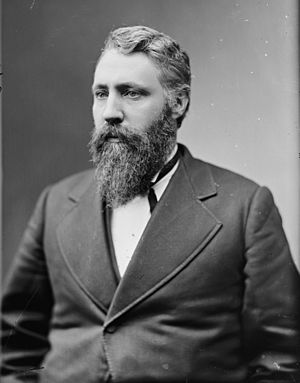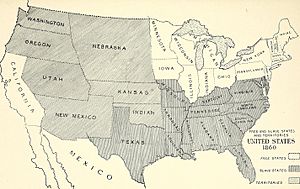J. Warren Keifer facts for kids
Quick facts for kids
Joseph Warren Keifer
|
|
|---|---|
 |
|
| 30th Speaker of the United States House of Representatives | |
| In office December 5, 1881 – March 3, 1883 |
|
| Preceded by | Samuel J. Randall |
| Succeeded by | John G. Carlisle |
| Member of the U.S. House of Representatives from Ohio |
|
| In office March 4, 1877 – March 3, 1885 |
|
| Preceded by | William Lawrence |
| Succeeded by | John Little |
| Constituency | 8th district (1877–1879) 4th district (1879–1881) 8th district (1881–1885) |
| In office March 4, 1905 – March 3, 1911 |
|
| Preceded by | Thomas B. Kyle |
| Succeeded by | James D. Post |
| Constituency | 7th district |
| Personal details | |
| Born | January 30, 1836 Bethel Township, Clark County, Ohio |
| Died | April 22, 1932 (aged 96) Springfield, Ohio |
| Political party | Republican |
| Alma mater | Antioch College |
| Profession | Law |
| Signature | |
| Military service | |
| Branch/service | United States Army Union Army |
| Years of service | 1861–1865, 1898–1899 |
| Rank | |
| Unit | 3rd Ohio Infantry Regiment |
| Commands | 110th Ohio Infantry Regiment 2nd Brigade, 3rd Division, VI Corps 7th Army Corps (1898–1899) |
| Battles/wars | American Civil War Spanish–American War |
Joseph Warren Keifer (born January 30, 1836 – died April 22, 1932) was an important American politician and a high-ranking military leader. He was a major general during the Spanish–American War. He also served in the United States House of Representatives for Ohio and was even the Speaker of the House from 1881 to 1883.
Contents
Early Life and Law Career
Joseph Warren Keifer was born in Clark County, Ohio in 1836. He went to Antioch College for his education. After college, he worked on his family's farm. While farming, he spent his free time studying law. He started his own law practice in Springfield, Ohio on January 12, 1858.
Military Service in the Civil War
When the American Civil War began, Keifer joined the 3rd Ohio Infantry as a major. He fought in battles in West Virginia, including Rich Mountain and Cheat Mountain. He was later promoted to lieutenant colonel.
After his first term of service, he joined the 110th Ohio Infantry and became its colonel. He led his regiment in the Eastern Theater of the war. His regiment fought in the second battle of Winchester. Even though the Union army was defeated, Keifer's regiment managed to avoid being captured.
Key Battles and Promotions
After the Battle of Gettysburg, Keifer was put in charge of a brigade in the III Corps. He fought at the Battle of Wapping Heights. Later, he and his regiment were sent to New York City to help stop the draft riots.
Keifer returned to the main Union army, called the Army of the Potomac. He was wounded in the arm during the Battle of the Wilderness. After recovering, he commanded the 2nd Brigade in the VI Corps. He led his brigade at the battles of Winchester and Fisher's Hill.
During the Battle of Cedar Creek, Keifer temporarily commanded the 3rd Division. For his brave service in the Shenandoah Valley Campaign, President Abraham Lincoln nominated him for a promotion. He became a brevet brigadier general of volunteers on December 12, 1864.
End of the War
When the VI Corps rejoined the Army of the Potomac, Keifer returned to leading the 2nd Brigade. He took part in the important breakthrough at Petersburg and the Appomattox Campaign. For his contributions, he was promoted again to brevet major general on April 9, 1865.
Political Career in Congress
After the Civil War, Keifer went back to Springfield and continued his law practice. He became a trustee for Antioch College in 1873 and served there until his death. In 1876, he was a delegate at the Republican National Convention. The next year, he was elected to the United States House of Representatives.
From 1881 to 1883, during the 47th United States Congress, Keifer served as the 47th Speaker of the House of Representatives. This is a very powerful position in the U.S. government. During his early years in the House, Keifer was part of the "Stalwart" group within the Republican Party.
Service in the Spanish–American War
During the Spanish–American War in 1898, President William McKinley appointed Keifer as a major general of volunteers. He commanded the 7th Army Corps. He also led the American forces that marched into Havana, Cuba, after Spanish forces left on January 1, 1899.
Later Political Life and Writings
After his military service, Keifer returned to private life in 1899. In 1900, he published a book called Slavery and Four Years of War. This book was about the history of slavery in the United States and also told about his own experiences during the Civil War.
He was the first commander-in-chief of the United Spanish War Veterans from 1900 to 1901. He also served as the Ohio commander of the Loyal Legion in 1903 and 1904.
Keifer ran for Congress again and was elected. He served in the House of Representatives from March 4, 1905, to March 3, 1911.
Final Years
After his long political career, Keifer went back to practicing law. He also became the president of the Lagonda National Bank in Springfield, Ohio. He passed away on April 22, 1932, at the age of 96, in Springfield. He is buried in Ferncliff Cemetery in Springfield.
See also
- List of American Civil War brevet generals (Union)
- James M. Moody


